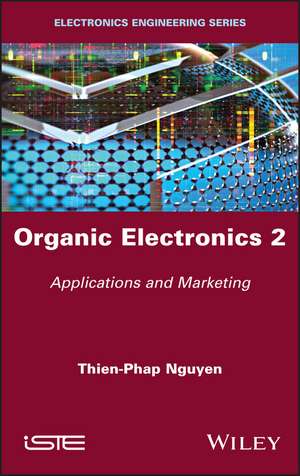Organic Electronics Volume 2 – Applications and Marketing
Autor TP Nguyenen Limba Engleză Hardback – 7 oct 2021
Preț: 979.60 lei
Preț vechi: 1076.48 lei
-9% Nou
Puncte Express: 1469
Preț estimativ în valută:
187.44€ • 196.23$ • 155.10£
187.44€ • 196.23$ • 155.10£
Carte tipărită la comandă
Livrare economică 05-19 aprilie
Preluare comenzi: 021 569.72.76
Specificații
ISBN-13: 9781786306104
ISBN-10: 1786306107
Pagini: 224
Dimensiuni: 156 x 234 x 16 mm
Greutate: 0.49 kg
Editura: ISTE Ltd.
Locul publicării:Hoboken, United States
ISBN-10: 1786306107
Pagini: 224
Dimensiuni: 156 x 234 x 16 mm
Greutate: 0.49 kg
Editura: ISTE Ltd.
Locul publicării:Hoboken, United States
Cuprins
Introduction ix
Chapter 1 Organic Light-Emitting Diodes 1
1.1 Introduction 1
1.2 Reminders on optics 2
1.2.1 Photometry and radiometry 2
1.2.2 Colors 3
1.3 OLED operating principle 6
1.3.1 P-N junction LED 6
1.3.2 OLEDs 15
1.4 OLED applications 35
1.4.1 OLEDs for lighting 36
1.4.2 OLEDs for display 37
1.4.3 OLEDs for automotive equipment 39
1.5 Conclusion 40
Chapter 2 Organic Solar Cells 41
2.1 Introduction 41
2.2 Solar spectrum 42
2.3 Operating principle 44
2.3.1 Absorption of photons 45
2.3.2 Diffusion of excitons 46
2.3.3 Dissociation of excitons 47
2.3.4 Diffusion of carriers to electrodes 50
2.3.5 Collection of charges 50
2.3.6 Process optimization for an organic solar cell 50
2.4 Characteristic parameters of solar cells 52
2.4.1 Current-voltage characteristics 52
2.4.2 Photovoltaic parameters of a solar cell 54
2.4.3 Efficiency 57
2.5 Organic materials 59
2.5.1 Electron donor materials 59
2.5.2 Electron acceptor materials 61
2.6 P3HT:PCBM 63
2.7 Perovskite 65
2.7.1 Structure of perovskite 66
2.7.2 Solar cells based on perovskite 67
2.7.3 Conversion efficiency 69
2.7.4 Problems with the use of perovskite solar cells 69
2.8 Solar cells based on organic, hybrid and silicon materials 73
2.9 Strategies to improve the performance of organic and hybrid solar cells 75
2.9.1 Low bandgap semiconductors 76
2.9.2 Tandem cells 78
2.10 Conclusion 82
Chapter 3 Organic Transistors 85
3.1 Introduction 85
3.2 Operating principle 86
3.2.1 Transistor effect 87
3.2.2 Field effect 88
3.3 Principal OFET parameters 95
3.3.1 Charge carrier mobility 96
3.3.2 Contact resistance 97
3.3.3 Hysteresis 101
3.3.4 Gate-bias stress effects, VGS 102
3.3.5 Ion/Ioff current ratio 102
3.4 Materials 103
3.4.1 Metals used for electrodes 103
3.4.2 Dielectric materials 104
3.4.3 Active organic materials 109
3.5 Ambipolar transistors and semiconductors 115
3.5.1 Ambipolar semiconductors 115
3.5.2 Ambipolar transistors 116
3.6 Light-emitting transistors 118
3.6.1 Ambipolar OLETs with BHJ structure 118
3.6.2 Single-semiconductor ambipolar OLETs 118
3.6.3 Vertical OLETs 120
3.7 OFET applications 121
3.7.1 RFID tags 121
3.7.2 Sensors 122
3.7.3 Active-matrix displays 123
3.8 Conclusion 124
Chapter 4 The Brabec Triangle 127
4.1 Introduction 127
4.2 Device efficiency 128
4.2.1 OLED efficiency 128
4.2.2 Solar cell efficiency 130
4.2.3 OFET performance 133
4.3 Stability of materials and devices 134
4.3.1 Process of degradation of organic materials and devices 135
4.3.2 Classification of device degradation mechanisms 137
4.3.3 Degradation of OFETs 143
4.3.4 Measuring the lifetime of devices 146
4.4 Organic device production cost and marketing 151
4.4.1 Production of OLEDs 152
4.4.2 Production of OSCs 153
4.4.3 Production of OFETs 155
4.5 Synthesis on Brabec's criteria 156
4.6 Environmental dimension 157
4.6.1 Life-cycle assessment 158
4.6.2 Levelized cost of energy 160
4.6.3 Energy payback time 160
4.6.4 Life cycle of organic solar cells 161
4.6.5 Fate of released pollutants 162
4.6.6 Mass production and environment 165
4.7 Prospects and developments 167
List of Acronyms 173
References 181
Index 197
